Hoka Challenger 7
Test Location: Marin, CA Test Duration: 95 miles Stated Stack Height (Men’s): 31 mm (heel) / 26 mm (forefoot) Stated Heel-to-Toe Drop: 5 mm Stated Features:- Engineered mesh upper
- Compression-molded EVA foam midsole
- Extended heel pull for ease of entry
- 4 mm lugs
- Shoes + Laces: 235 g (left) & 235 g (right)
- Insoles: 14 g (left) & 14 g (right)
- Total: 249 g (left) & 249 g (right)
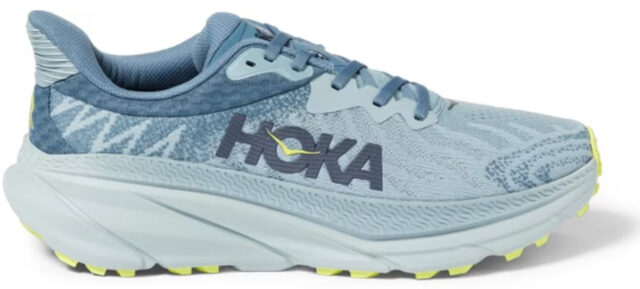
MSRP: $145
Size Tested: US Men’s 8.5 / EU 42
Reviewer: 5’9”, 150 lbs / 175 cm, 68 kg
Intro
Perhaps in an attempt to reinvigorate a line that has gone slightly stale, Hoka has completely redesigned the Challenger 7, a renovation that delivers a substantial drop in weight from its predecessor, a higher stack height, and a new upper construction. I’ve been splitting my running between roads and trails this winter, and after my first 15 miles in the Challenger 7, I’m beginning to get a sense of some of the advantages and disadvantages of what Hoka’s redesign could offer long-term. But for now, we’ll take a closer look at the makeup of the shoe, and then follow up with a full-length review down the road. about its only quality not to have received an overhaul.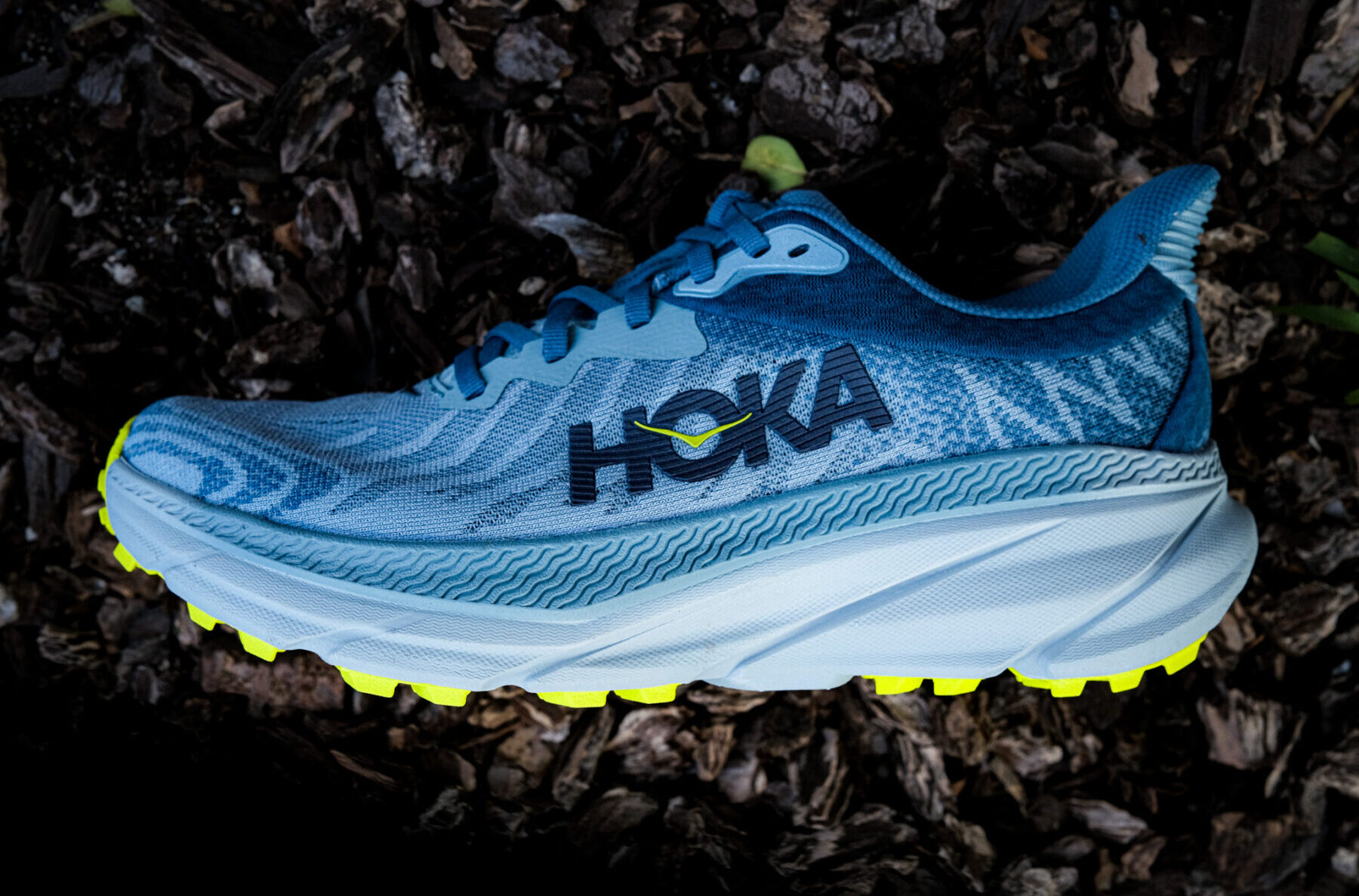
Fit & Features
Working from top to bottom, the most apparent change to the Challenger 7 from past iterations is its upper. Hoka has taken to using thin, tightly woven mesh material with interworked overlays to construct the uppers of recent models and the Challenger 7 receives a similar treatment in the form of a single piece of engineered mesh that wraps the entire shoe. Aside from a small toe cap that extends from the front of the outsole, the Challenger 7’s upper is sparsely decorated, devoid of any protective midfoot overlays typically seen on trail models. The shoe’s heel collar shares a strong resemblance to what’s seen on the Speedgoat 5; both are amply cushioned to cradle the Achilles and feature an extended pull-tab. And while the Challenger 7’s tongue is a bit more padded than the Speedgoat 5’s, both are fully gusseted.
Hoka is notoriously unforthcoming about divulging details about their midsole foam compounds, and the only information they provide about what’s used in the Challenger 7 is that it’s a new blend of compression-molded EVA. Because the shoe manages to shed 23 g of weight while increasing its stack height by 2 mm from its previous iteration, it’s safe to assume that this type of foam is at least a bit lighter than what the brand has used in the past. For reference, here’s how the Challenger 7’s stated weight compares to the stated weights for some other similar models, including the Challenger ATR 6. All weights are based on a US Men’s Size 9.
240 g / 8.5 oz — Hoka Zinal
247 g / 8.7 oz — Hoka Torrent 3
252 g / 8.9 oz — Hoka Challenger 7
270 g / 9.7 oz — Nike React Pegasus Trail 4
275 g / 9.7 oz — Brooks Catamount 2
278 g / 9.8 oz — Hoka Challenger ATR 6
289 g / 10.2 oz — Altra Outroad
303 g / 10.7 oz — Altra Timp 4
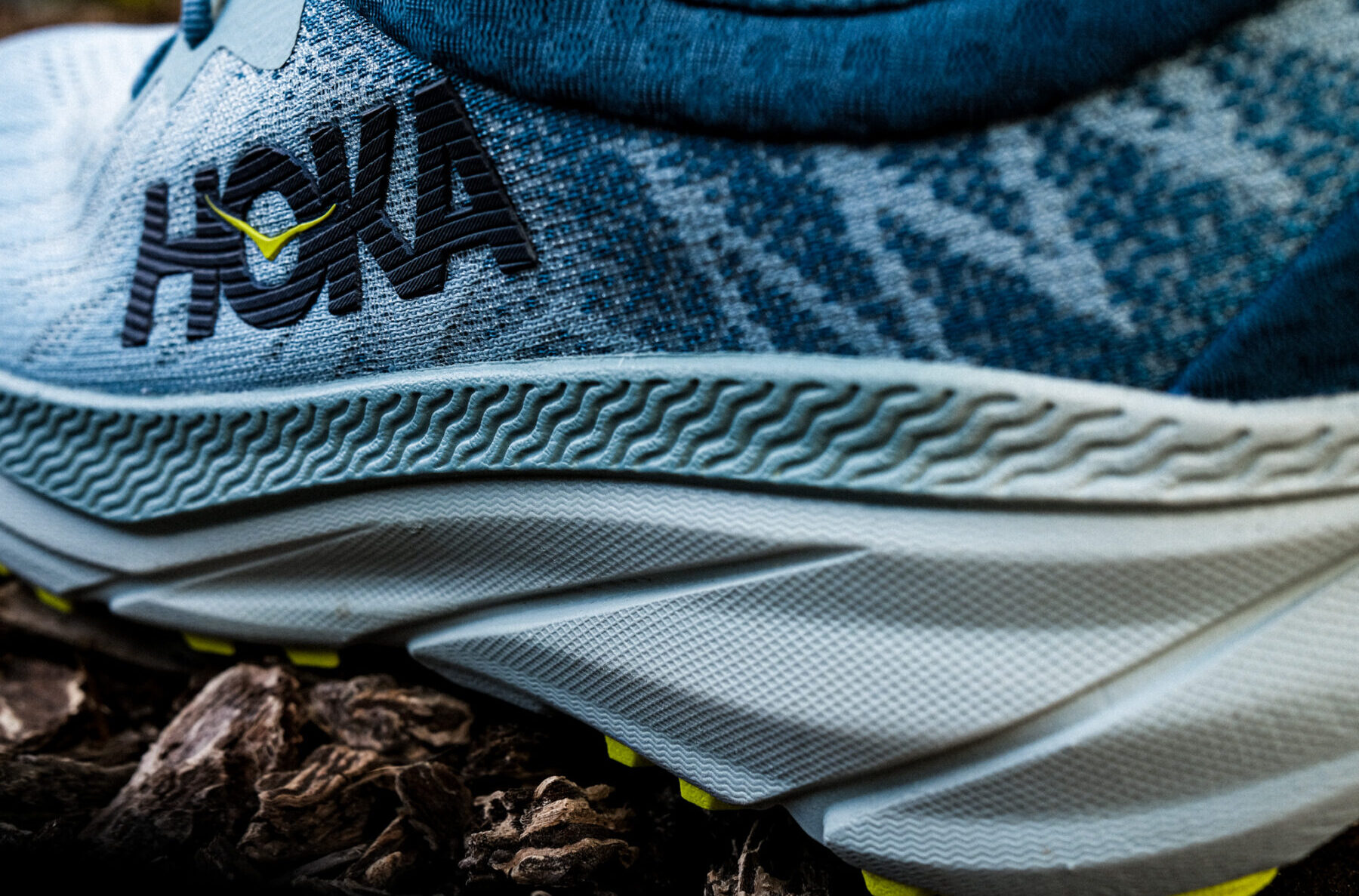
I’m not entirely sure why Hoka chose to push the Challenger 7’s stack height up to 31 mm / 26 mm, but after a handful of miles in the shoe, I can’t say I don’t support the decision quite yet. Though not nearly as energetic as the supercritical foam midsoles Hoka uses in models like the Tecton X and Carbon X 3, the Challenger 7’s midsole has provided plenty of pop on the road and softened impact on the moderately technical trails I’ve taken it on so far. The shoe retains the same 5 mm drop as the Challenger 6, but the heel counter has been both broadened and built up, which I think contributes to a rockered geometry that caters to quick miles on the road, particularly for folks who heel strike.
Traction on hybrid shoes can be a difficult needle to thread; prominent lugs can really hinder performance on hard concrete, but too tame of a tread can undermine the shoe’s ability to gain purchase on loose trail. Hoka’s approach to the Challenger 7 consists of outfitting it with a partially lugged outsole with tightly grouped 4 mm lugs confined to under the forefoot / heel with sections of exposed EVA foam under the midfoot. So far, this combination has seamlessly transitioned between road and rolling sections of buffed-out singletrack, conditions that I think the shoe is positioned to tackle with ease. Over the coming weeks, I plan on exposing it to increasing levels of technicality in hopes of finding its limit.
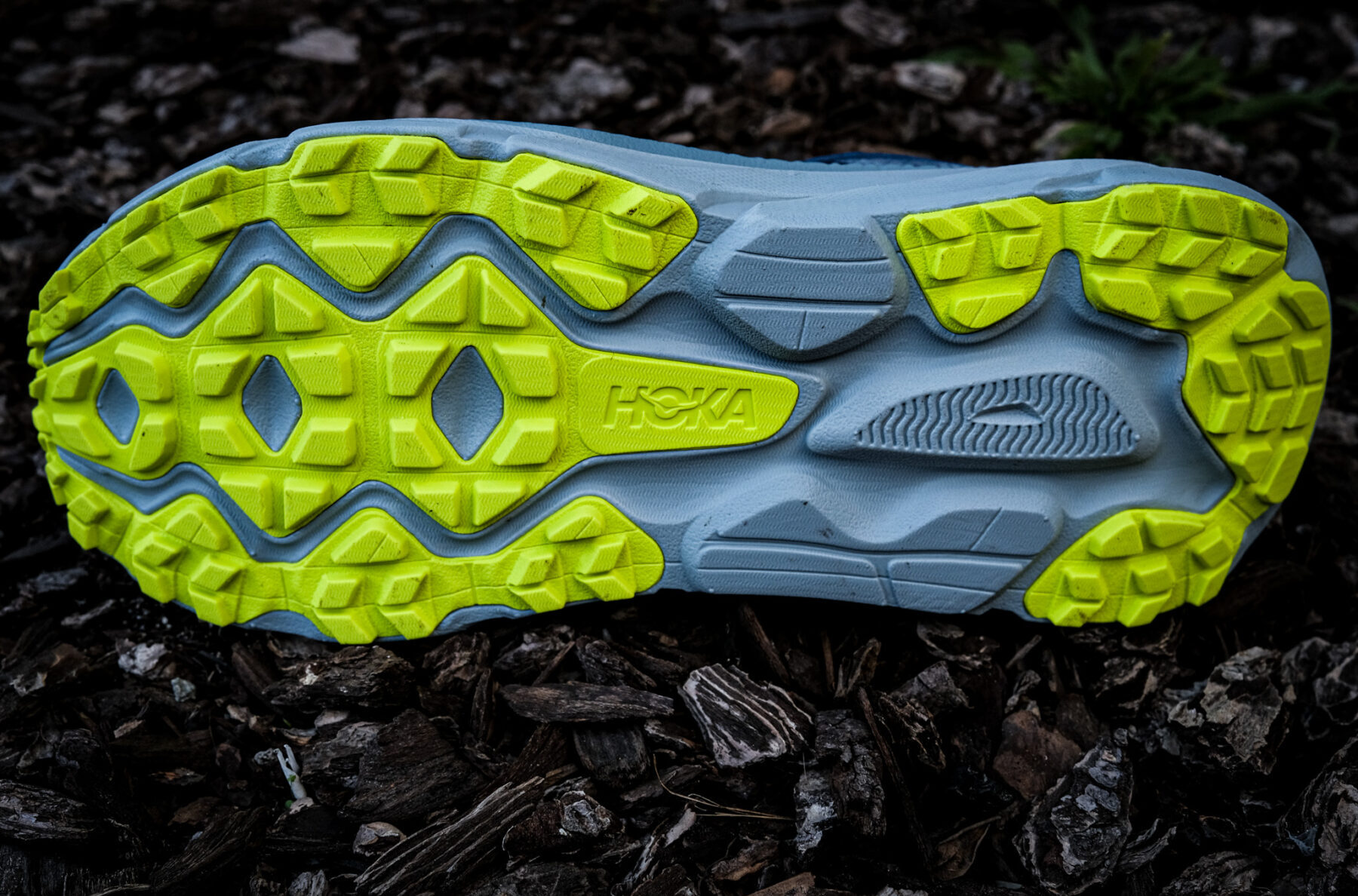
Some Questions / Things We’re Curious About
- Increasing stack height while simultaneously decreasing weight is a move that makes me a bit concerned about the resilience of Hoka’s new midsole foam. While the shoe feels sprightly and well-cushioned so far, I wonder if Hoka’s gamble will come back to bite them as the Challenger 7 approaches triple-digit miles?
- I’ve run into issues with outsole delamination on Hoka models that have employed segmented sections of tread separated by exposed EVA. Will this pattern continue on the Challenger 7?
- Most “all-terrain” shoes favor a specific surface type. What will the Challenger 7 naturally perform best on?
Bottom Line (For Now)
The updates made to the Challenger 7, the brand’s longstanding road-to-trail model, involve a complete overhaul that sees its weight decrease, its midsole add stack height, and its upper receive a serious facelift. Though the shoe’s narrowness might distance it from runners with average to wide foot shapes, for folks it does fit, the Challenger 7 has all the makings to be an accessible road-to-trail option for just about anyone who splits their time between dirt and tarmac.How well the paradoxically lighter yet more cushioned Challenger 7 holds up to constant wear, and whether it biases more toward road or trail, will both be focal points for our upcoming full review. Stay tuned.
FULL REVIEW
Intro
Hoka’s number of trail shoe models has proliferated over the last couple of years, an expansion that has seen the introduction of models like the Mafate Speed 4, Tecton X, and Zinal, and many have felt that one of the brand’s longest-tenured lines, the Challenger, has in some ways become vestigial, or at the very least, a bit stagnated. Nominally Hoka’s road-to-trail shoe, previous iterations of the Challenger bore the acronym “ATR,” or “All-Terrain,” in their title. While the recently launched Challenger 7 drops that abbreviation, its role as a multifaceted option that can easily pivot between dirt and tarmac remains unchanged, which is just about its only quality not to have received an overhaul.
The latest iteration of the Challenger takes on both the design aesthetics and performance upgrades that have characterized Hoka’s lineup as of late. The shoe naturally drops some weight from its predecessor, gains a few millimeters of stack height, and benefits from an inventive new upper construction. As I’ve increased my weekly mileage beginning at the outset of spring, the Challenger 7 has nudged its way into my lineup. Now with nearly 100 miles in the shoe, I’m ready to answer some of the questions we posed about its durability and potential in the initial phase of our review above.
Fit
Because the Challenger 7 is so heavily modified, it’s hard to really compare to its predecessor in the Challenger ATR 6, outside of saying that both are positioned as Hoka’s road-to-trail option and share some identity with the Clifton model, Hoka’s ever-popular neutral road trainer. However, whereas the ATR 6 felt more like a veritable trail shoe, in my opinion, the Challenger 7 skews more toward the type of fit I’ve come to expect from road models. This is mainly expressed in the shoe’s tapered last and snug upper, which, while providing ample foot security at quicker paces, can inhibit toe splay and potentially inconvenience runners with wider foot shapes.
Speaking anecdotally, the Challenger 7’s low-volume toe box and lightweight mesh upper conspired to absolutely abuse my pinky toes on my first run, rubbing them raw after just a few miles. This problem quickly cleared up once the shoe broke in (a rarity for most Hokas, which tend to be good to go out of the box) but I imagine I’m likely stuck with the minimal amount of room I have in the forefoot. I should also add that my pair of Challenger 7s ran true to size, though I’d consider going up by a half-size with my next pair to see if doing so could grant me a bit more room up front for my slightly wide, high-volume feet.
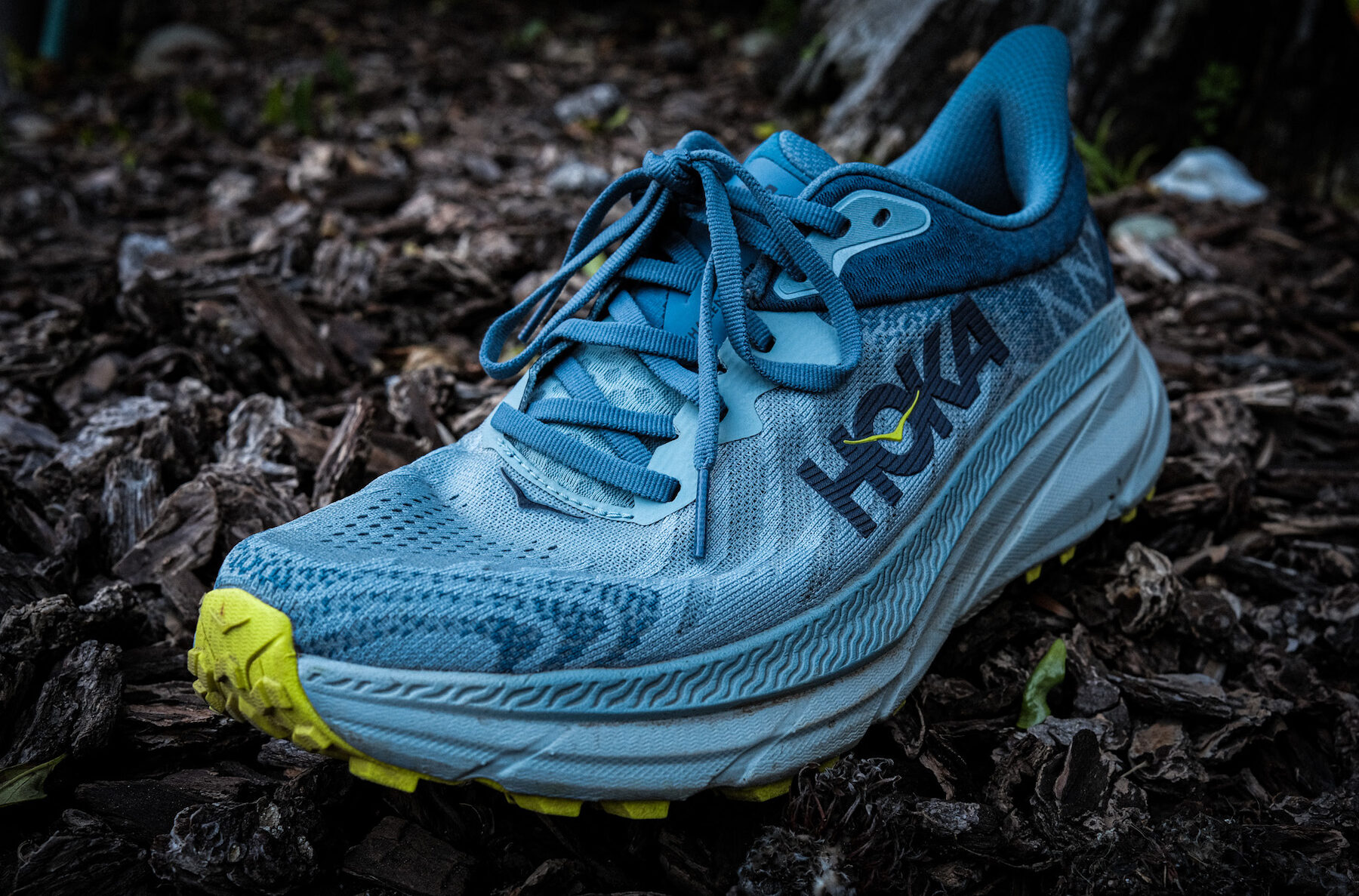
Weight
Adding stack height whilst reducing weight is no easy feat, yet Hoka manages to gracefully pull both off in the Challenger 7, a shoe that’s reportedly 23 g lighter than its predecessor all the while having a midsole that’s 2 mm thicker. For reference, here’s how the Challenger 7’s stated weight compares to the stated weights for some other similar models, including the Challenger ATR 6. All weights are based on a US Men’s Size 9.
240 g / 8.5 oz — Hoka Zinal
247 g / 8.7 oz — Hoka Torrent 3
247 g / 8.7 oz — Hoka Clifton 9
252 g / 8.9 oz — Hoka Challenger 7
270 g / 9.7 oz — Nike React Pegasus Trail 4
275 g / 9.7 oz — Brooks Catamount 2
278 g / 9.8 oz — Hoka Challenger ATR 6
289 g / 10.2 oz — Altra Outroad
303 g / 10.7 oz — Altra Timp 4
306 g / 10.8 oz — Hoka Bondi 8
This reduction in weight is likely as good a sign as any that the Challenger 7 biases more toward a road shoe that can handle light amounts of off-road travel than a true trail model that can get by on the odd stretch of pavement. (Most road-to-trail options are unbalanced in that way, it’s just good to get a sense of which direction.) Regardless of terrain, the Challenger 7 fits in where you’d expect it to: commensurate with lower-stack trail shoes and higher-stack road shoes.
Upper
Hoka has employed thin, tightly woven engineered mesh materials with interworked overlays to construct the uppers of recent models as of late and the Challenger 7 receives a similar treatment. The shoe features a single piece of engineered mesh that wraps the forefoot and midfoot with tiger-striping used to indicate where the material is reinforced. Aside from a small toe cap that extends from the front of the outsole, the Challenger 7’s upper is without any protective midfoot overlays typically seen on trail models. Instead, a slightly more rigid piece of material on the inside of the shoe backs the rubber toe cap, where you’d traditionally expect a layer of TPU. Considering its intended use as a road-to-trail option, the front half of the Challenger 7’s upper makes a ton of sense from a design standpoint; it’s simultaneously lightweight and ventilated but still retains enough protective touches to safeguard feet on surfaces like buffed-out singletrack and fire roads.

Midsole
I keep getting back to the notion that a lot of what Hoka did in the Challenger 7’s redesign is counterintuitive, and nowhere else is that manifested more than in the shoe’s midsole. First, you’d think that adding more stack height would reflect in a heavier weight — not so. Second, a thicker midsole should provide more cushioning — again, that’s not the case, at least in my experience. So what gives?
Hoka is notoriously tight-lipped when it comes to sharing details about their midsole foam compounds, and the only information they provide about what’s used in the Challenger 7 is that it’s a new blend of compression-molded EVA. Under foot it feels both lighter and denser than what they’ve used in past models; not unforgiving but definitely quite a bit more rigid than the tender midsole foam I grew accustomed to in the Speedgoat 5. Like most Hokas with stacks in the 30s, the Challenger 7 takes advantage of a rockered geometry and flared-out platform to help stabilize its height. The combination of the two — i.e., lightweight, firm material organized into a rockered shape — created plenty of energy return that was able to power a quick transition through my gait cycle. That said, I did notice that the Challenger 7’s new compression-molded EVA foam midsole lacked in ground feel, an attribute you’ll likely miss if you plan on frequently taking the Challenger 7 on trails, but something that might not be of much importance if you’re spending the majority of your time on the road.
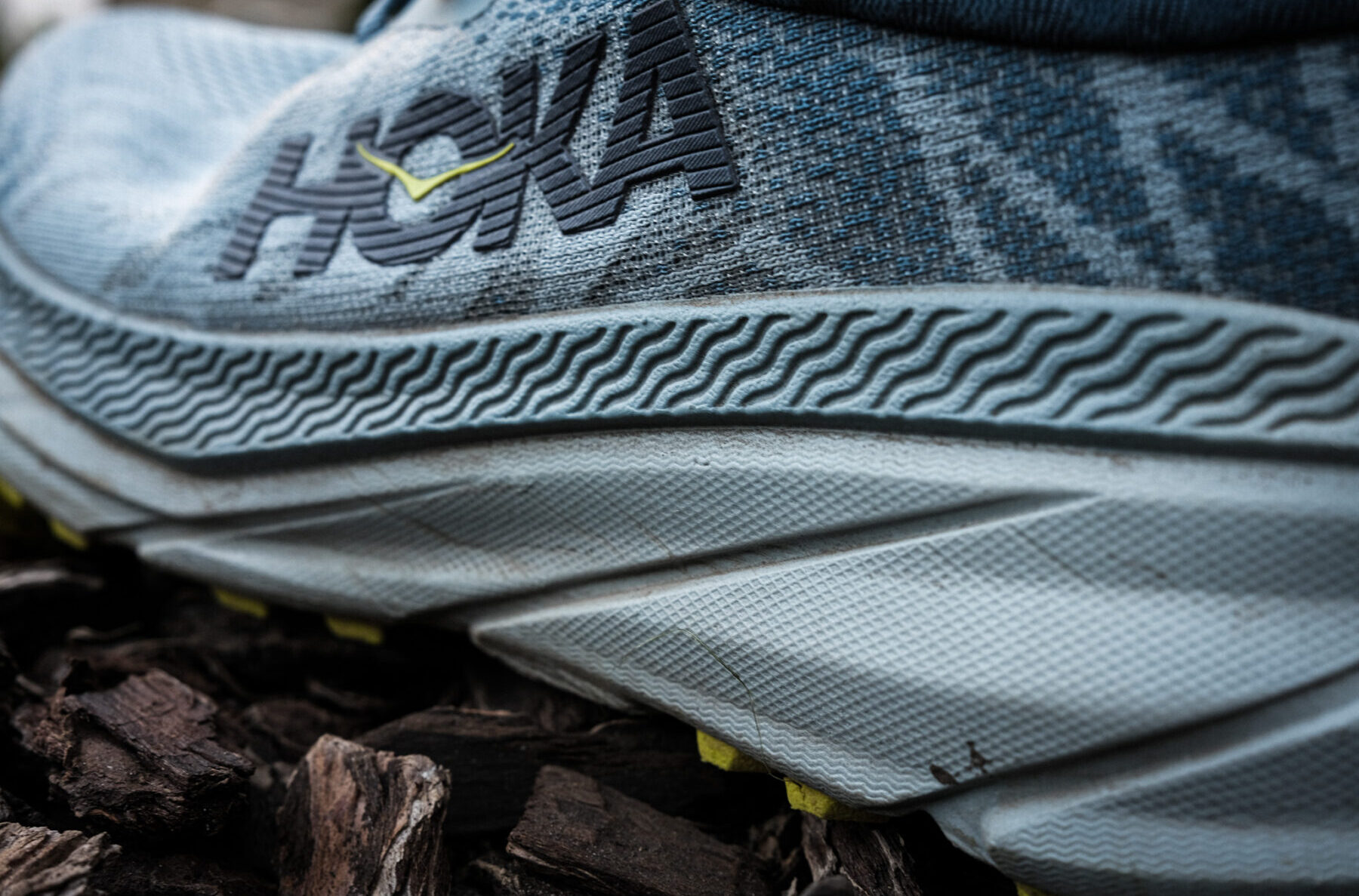
Outsole
So far we’ve covered aspects of the Challenger 7 that are completely new for this iteration, areas of the shoe Hoka figured could be drastically improved with updates. The Challenger 7’s outsole, however, is pretty much a holdover from what’s used on its predecessor in the Challenger 6 ATR. The decision to stand pat with respect to this part of the shoe is one I agree with; the segmented outsole with 4 mm lugs has enough teeth to find purchase on mild to moderately technical terrain while at the same time feeling pretty quick and efficient on pavement.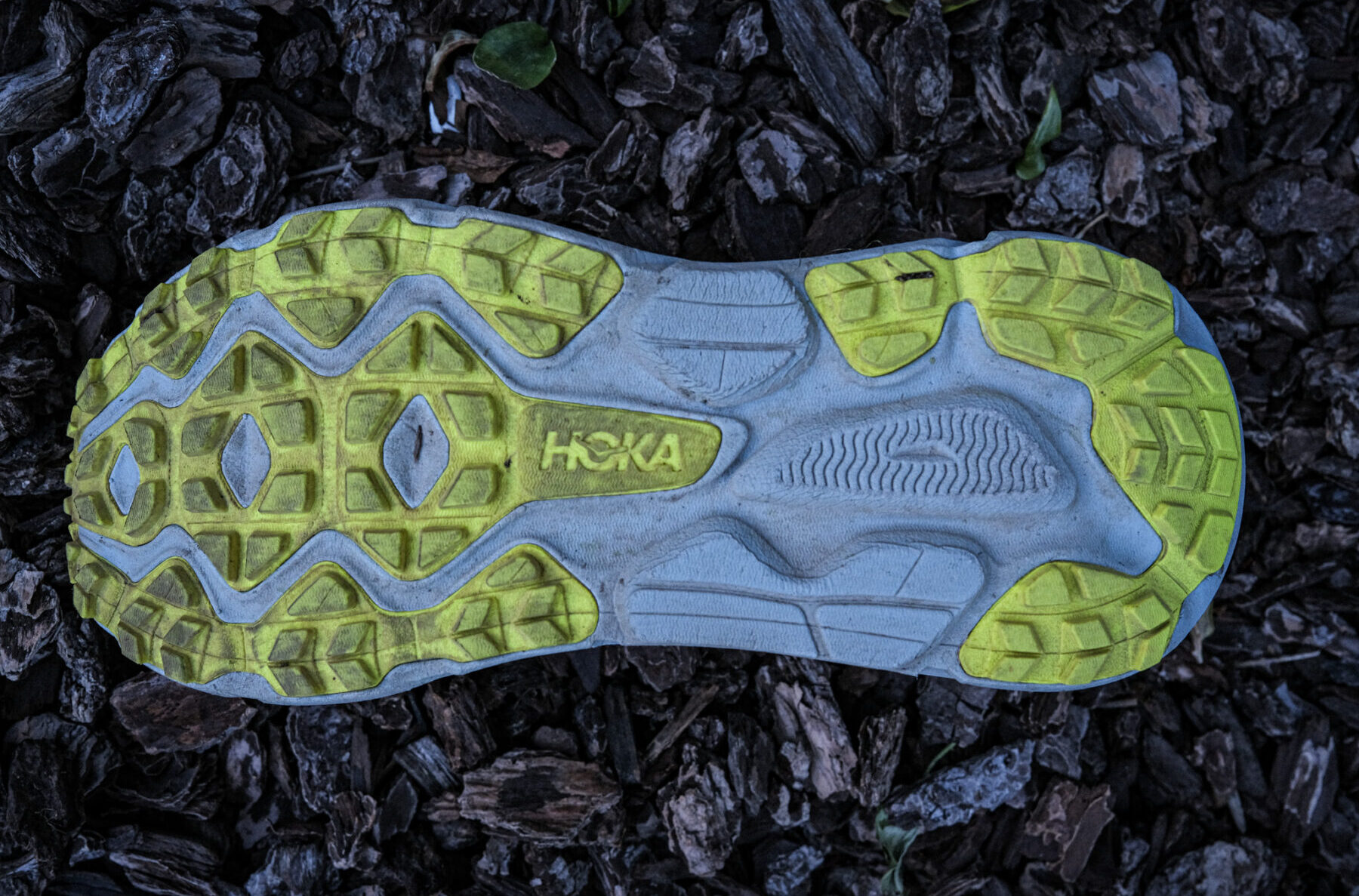
On Trail (and Road)
Whenever I set about reviewing a shoe that purports to be a road-to-trail model, I’m always interested in teasing out what kinds of “trails” are implied. Is this a shoe that can hold its breath while running on gravel roads and survive them, letting out a huge exhale once back on uniform tarmac? Or does it invite me to push its comfort zone by tackling rough sections of loose singletrack that cut through my neighborhood streets? I personally tend to favor the latter and look to the Inov-8 Parkclaw G 280 as an example of a shoe that did that incredibly well.
In line with this approach, of the roughly 95 miles I’ve spent in the Challenger 7 so far, I’d say 70 of them have been on some form of dirt. Marin, CA offers a diverse array of terrain types, with everything from mellowly graded fire roads to scrambly sections of unmaintained singletrack, and because of its layout, I was often able to connect trails of varying technicality together in a single long run.
At the outset of one of these 20+ mile outings, the Challenger 7 made its limits known pretty quickly. My warm-up consisted of a few road miles, which the shoe ate up hungrily — its understated outsole, lack of weight, and fairly inflexible midsole loved the consistency and firmness of running on concrete. This ride carried over when the surface beneath my feet transitioned to compact fire road, too, though cornering while descending on parched sections of kitty-litter did put pressure on the shoe’s tread. I spun out a few times, but to the Challenger 7’s credit, I think even most dedicated trail shoes would have had trouble keeping their rubber side down on surfaces like that.
The route I planned, a point-to-point from the Marin Headlands to the top of Mt.Tam, took me on increasingly more difficult trails, and while the Challenger 7 perked up on paved roads, gravel fire roads, and buffed-out singletrack, the shoe started to complain quite a bit once introduced to rocky / rooty surfaces. Factors like its narrow last, insubstantial upper, lack of tread, lack of protective overlays, and poor ground feel conspired to make running on technical trails a poor experience. Simply put, the Challenger 7 felt incompatible with the level of agility, stability, protection, and precision needed on rock-strewn trails that are frequently steep and twisting — and that’s totally ok! From the start, the shoe felt like a hybrid between the Hoka Speedgoat 5 and the Hoka Clifton 9, two accomplished models in their respective domains, and its performance out in the wild accurately reflected that comparison. For that reason, if you run a ton of fire roads, I’d be hard-pressed to think of a better option than the Challenger 7 (fit being the main caveat).
Durability
How long the Challenger 7 will last you depends entirely on the types of terrain you subject it to. While this is technically the case with any trail shoe, it’s heightened in road-to-trail models that, on the whole, tend to deprioritize protection, especially on their uppers. As I mentioned above, I’ve been heavily favoring dirt while testing the Challenger 7 and the shoe is beginning to show signs of that just 95 miles in. The engineered mesh that acts as the ceiling to the Challenger 7’s toe box is thoroughly creased from use (likely exacerbated by my forefoot strike) and angrily puffed out where it joins the midsole (likely exacerbated this time by my wide foot).
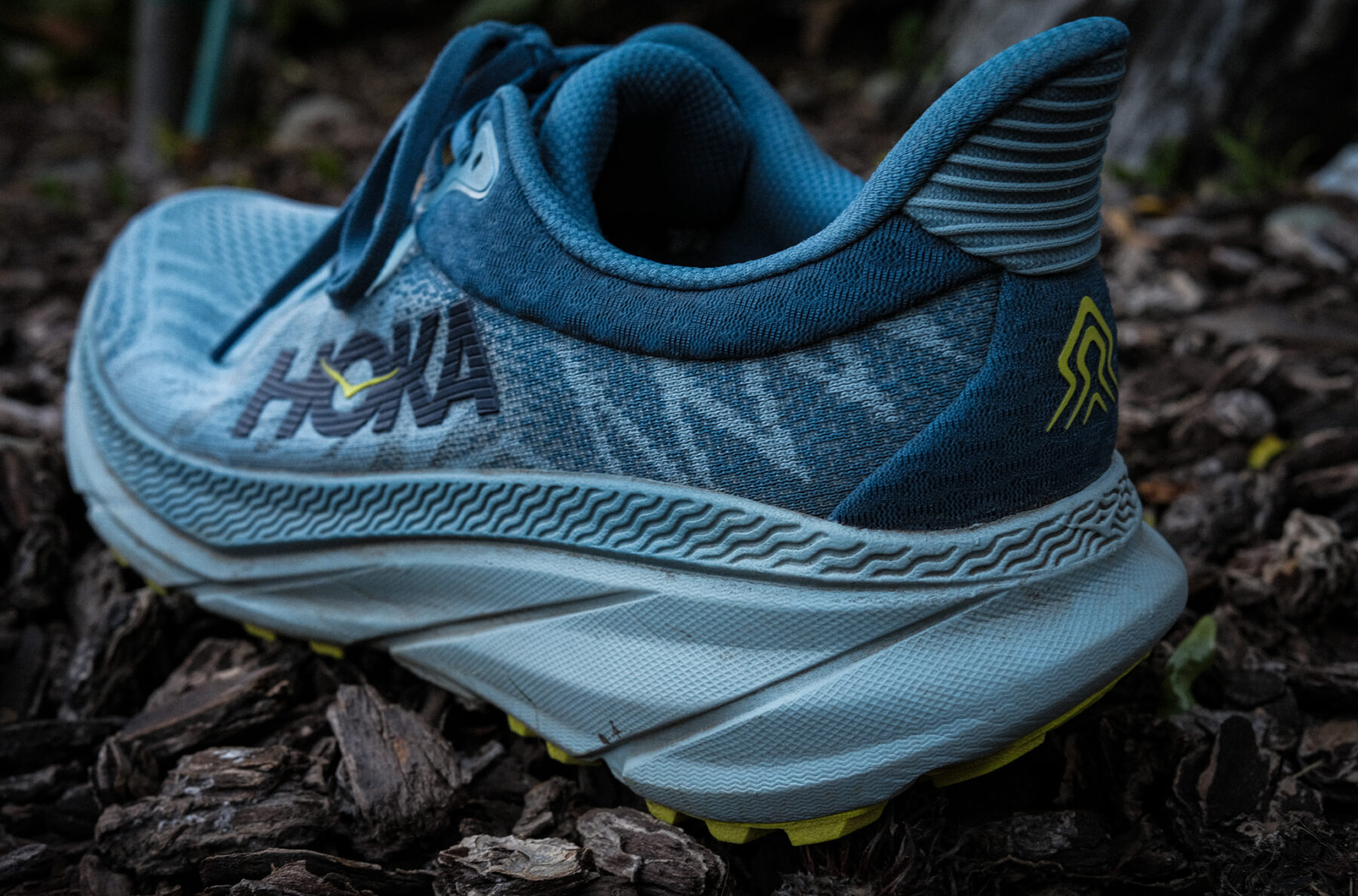
Who’s It For?
In my experience, road-to-trail shoes tend to benefit runners who live in urban areas with access to open space (for a larger conversation about urban trail running, check out Off The Couch Ep. 163 with Ryan Scura). The Challenger 7 is an example of a model that manages to stay fairly unbiased when it comes to which side of the road / trail spectrum it favors. As such, I think it makes the most sense for folks whose runs routinely involve mixed terrain of just about any distance, whether that’s commuting to a local trail system via paved streets or linking up stretches of city trails from your doorstep.
While the Challenger 7’s versatility should make it an approachable option for many, the shoe’s distinct lack of available space in the forefoot / toe box will likely be an issue for runners with wide feet. Though the Challenger 7’s upper expands some once past the break-in period, there’s almost no escaping its narrow last, which can cause feet to feel cramped and also contribute to instability on off-camber surfaces. Fortunately, Hoka has made the Challenger 7 available in a 2E, so if you’re even slightly concerned about width, consider opting for the wide version of the shoe.
Bottom Line
With the Challenger 7, Hoka attempts to do more with less. The latest iteration of the brand’s longstanding road-to-trail model benefits from a top-to-bottom overhaul that sees its weight decrease significantly from past versions of the shoe. At the same time, Hoka’s reformulated EVA foam compound adds 2 mm of stack height to a compression-molded midsole that feels sprightly out of the box. While the narrowness of the standard version of the Challenger 7 might distance it from folks with average to wide foot shapes, the shoe is available in a 2E width, which should make it an accessible road-to-trail option for just about anyone who splits their time between dirt and tarmac. If you’re a Hoka acolyte looking for a hybrid between the Speedgoat 5 and the Clifton 9, or you just enjoy cruising on roads — paved, gravel, or otherwise — I’d highly encourage you to check out the Challenger 7.

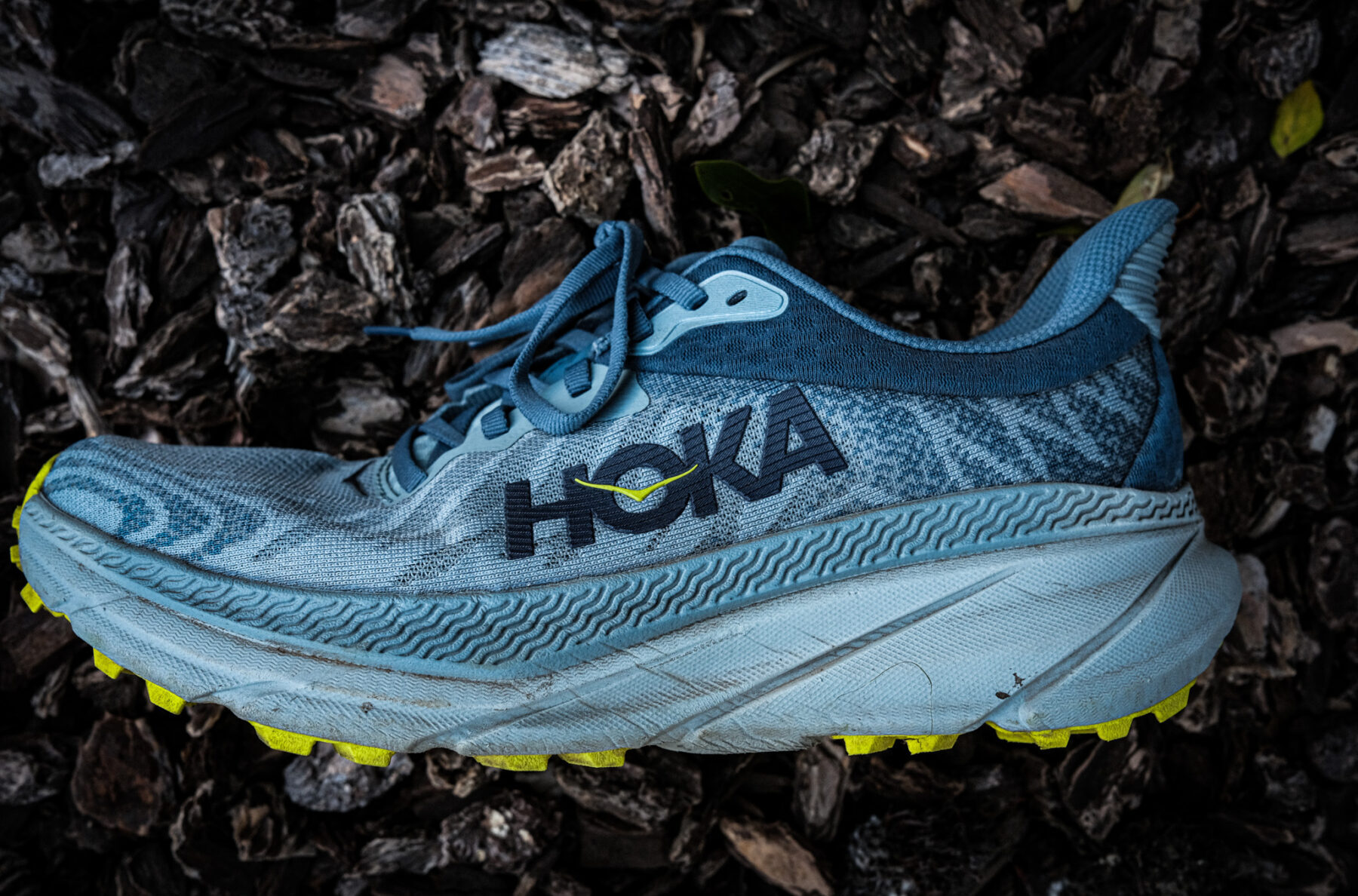
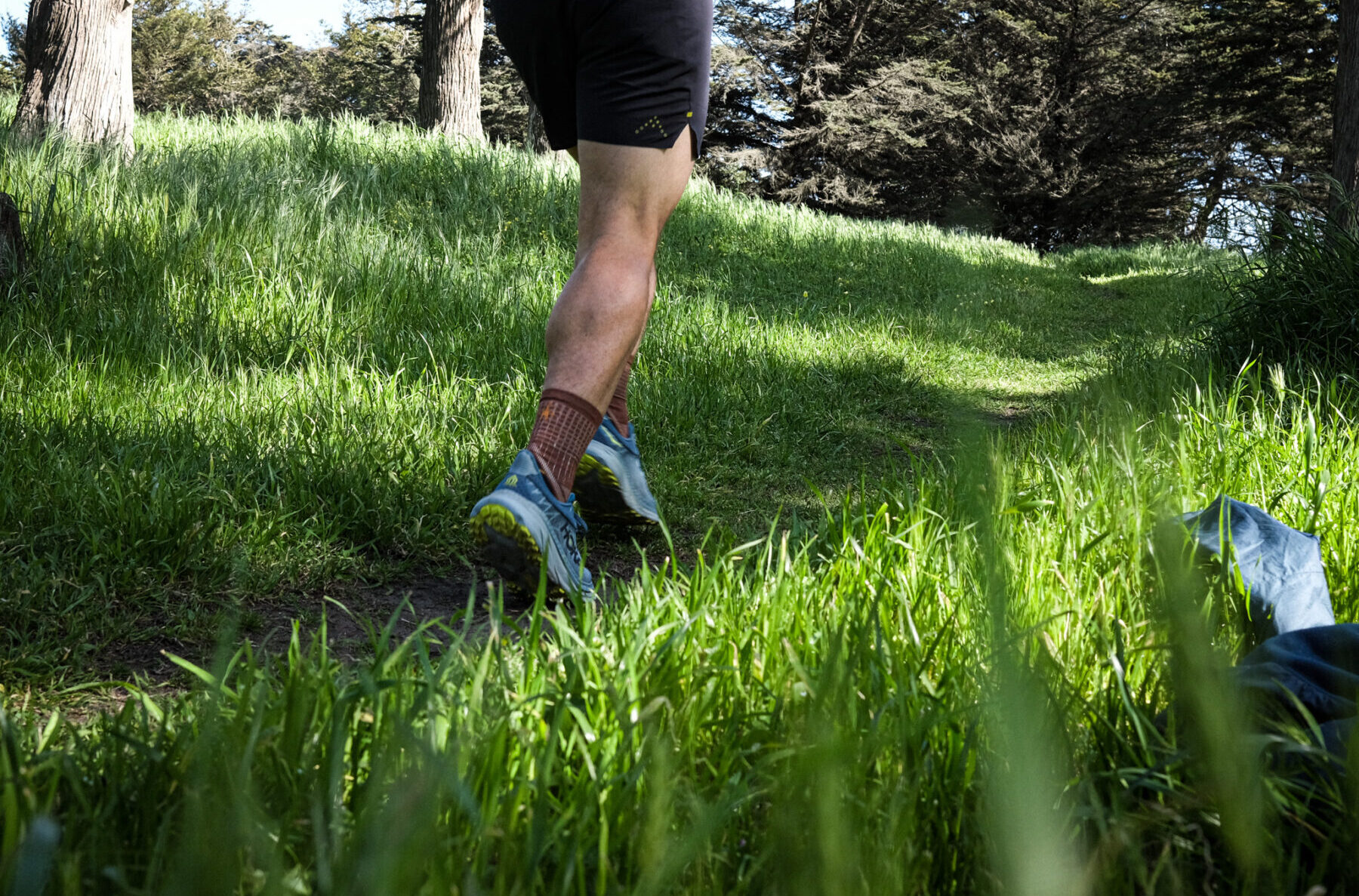

I bought a pair of REI a week ago. I normally buy the heavier Stinson ATR. I needed a shoe that’s more nimble. But I still need shoes where I can run downhill without busting my knees. So far they seem to work pretty well, but they’re not as fast on the downhill as I would like. I’m hoping the lightweight will compensate for that.
I loved the firm yet responsive foam and weight, but sadly the narrow mid-foot, shallow toe box and seam along the outer side is causing serious pain. This is even on the 2E…I’m going to have to send them back. :(